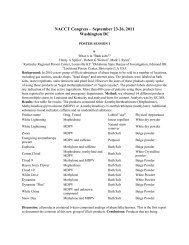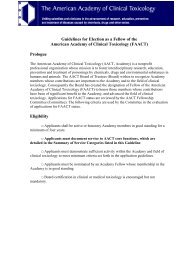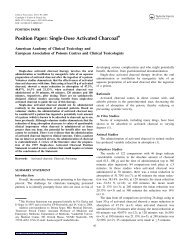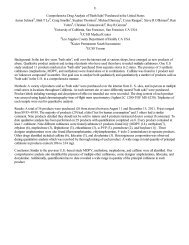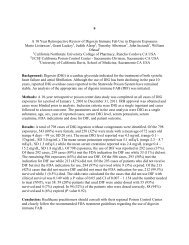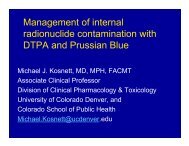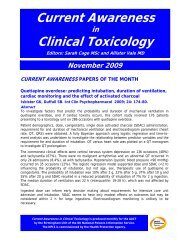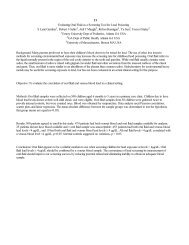Posters IV - The American Academy of Clinical Toxicology
Posters IV - The American Academy of Clinical Toxicology
Posters IV - The American Academy of Clinical Toxicology
Create successful ePaper yourself
Turn your PDF publications into a flip-book with our unique Google optimized e-Paper software.
contracture <strong>of</strong> the right face and received lorazepam 2 mg. Pupils were equal and sluggishly reactive. She<br />
withdrew to pain. Heart, lungs, and abdomen were unremarkable. She was intubated for airway protection.<br />
Initial labs were significant for arterial pH 7.12, pCO2 41, pO2 220, Na 138 mmol/L, K 3.6 mmol/L, Cl<br />
104 mmol/L, CO2 16 mmol/L, AG 18, BUN 7 mg/dL, creatinine 0.6 mg/dL, glucose 198 mg/dL, Ca 9.2<br />
mg/dL, ALT/AST 31/51 U/L, lactate 5.1 mmol/L, CK 91 U/L, ketones negative, urine: no crystals, ECG:<br />
ST 111, QRS 82, QTc 413. Ethanol, acetaminophen, salicylate, methanol, and ethylene glycol were<br />
undetectable. Head CT, CSF cell counts and chemistries were normal. After transfer to a children's<br />
hospital, EEG showed diffuse slowing, consistent with encephalopathy. A bicarbonate infusion was begun<br />
for acidemia, and stopped 2 days later when the patient was extubated. Family found a bottle <strong>of</strong> ibupr<strong>of</strong>en<br />
800 mg in her room with 70 pills (56 g) missing. Serum ibupr<strong>of</strong>en level was > 250 mcg/mL (therapeutic<br />
10-50). <strong>The</strong> patient developed transient hyperrnatremia to 159, which resolved by hospital day 2. At<br />
transfer from the ICU, she had uncoordinated movements <strong>of</strong> all extremities. By post-ingestion (PI) day 3,<br />
mental status had normalized, but she was unable to ambulate due to ataxia. She received physical therapy<br />
twice daily. On PI day 4 she could ambulate with assistance. On PI day 6, she was able to tandem walk<br />
without deficit. She recovered fully and was transferred to a psychiatric unit. Discussion: Acidosis,<br />
seizure, and CNS depression have been reported with large ibupr<strong>of</strong>en overdoses. In this case, a previously<br />
unreported finding <strong>of</strong> gait ataxia was prominent, requiring physical therapy and prolonging hospital stay.<br />
Ataxia resolved by PI day 6, making anoxic injury an unlikely etiology. Comprehensive drug screening<br />
was not done, but according to the patient, her family, and pharmacy, she had no access to other<br />
medications. Although the mechanism is unclear, other etiologies <strong>of</strong> ataxia seem unlikely. Conclusion:<br />
Ataxia may be a previously unrecognized complication <strong>of</strong> severe ibupr<strong>of</strong>en toxicity. Further study is<br />
warranted to elucidate the mechanism.<br />
306<br />
Acute Acepromazine Overdose: <strong>Clinical</strong> effects and toxicokinetic evaluation<br />
D. Adam Algren, Amber Ashworth<br />
Background: Acepromazine, a phenothiazine derivative, is used as sedative in veterinary medicine. Cases<br />
<strong>of</strong> acepromazine overdose are infrequently described and toxicokinetic data has not been previously<br />
reported. We report a case <strong>of</strong> intentional acepromazine overdose resulting in central nervous system<br />
(CNS)/respiratory depression and hypotension with confirmatory toxicokinetic data. Case Report: A 54<br />
year old woman reported intentionally ingesting 950mg <strong>of</strong> her dog's acepromazine. She denied other coingestants.<br />
Her past medical history was significant for depression, anxiety, and hypothyroidism. She<br />
denied current medication use. She was evaluated in an emergency department within 1 hour <strong>of</strong> her<br />
ingestion and was alert with normal vitals signs. Physical examination was unremarkable. Activated<br />
charcoal was administered. CBC, electrolytes and LFT's were normal. Serum acetaminophen, salicylate<br />
and alcohol were undetectable. Urine drug screen was negative for drugs <strong>of</strong> abuse. An EKG demonstrated<br />
normal intervals. Over the proceeding two hours the patient developed increasing somnolence, tachycardia<br />
and hypotension. <strong>The</strong> HR ranged from 100-130/min and the systolic BP was 70 mmHg. ABG<br />
demonstrated a mild respiratory acidosis. Bipap and a norepinephrine drip were instituted. <strong>Clinical</strong>ly she<br />
improved over the next 12 hours at which time the Bipap and norepinephrine were discontinued. Repeat<br />
laboratory studies and EKG's remained normal and the patient was transferred to a psychiatric facility the<br />
following day. Serial plasma acepromazine levels were determined using GC/MS. <strong>The</strong> initial<br />
acepromazine level (1 hour post-ingestion) was 63 ng/ml. Follow up levels at 8, 10.5 and 13.5 hours post<br />
ingestion were 7.6 ng/ml, 8.9 ng/ml and 6.3 ng/ml, respectively, resulting in an elimination half-life <strong>of</strong> 3.1<br />
hours. Case discussion: Acepromazine is structurally similar to chlorpromazine. It is used in dogs and



